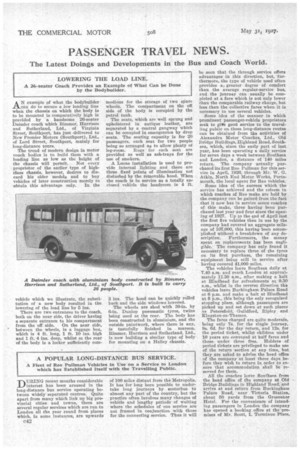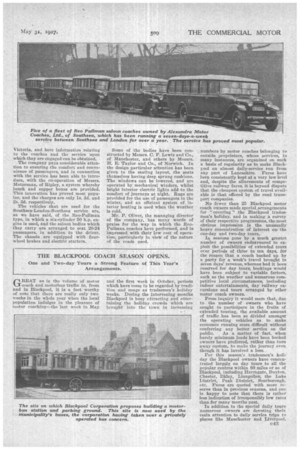A POPULAR LONG-DISTANCE BUS SERVICE.
Page 64

Page 65

If you've noticed an error in this article please click here to report it so we can fix it.
A Fleet of Reo Pullman Vehicles in Use on a Service to London which has Established Itself with the Travelling Public.
IJIIRING recent months considerable _L./interest has been aroused in the long-distance bus service operating between widely separated centres. Quite apart from many which link up big provincial cities and towns, there are several regular services which are run to London all the year round froin places which, in some instances, are upwards
C42 of 100 miles distant from the Metropolis. It has for long been possible to undertake long journeys by motorbus to almost any part of the country, but the practice often involves many changes of vehicle and lengthy periods of waiting where the schedules of one service are not framed in conjunction with those for the connecting service. Thus it will be seen that the through service offers advantages in this direction, but, furthermore, the type of vehicle used often provides a. greater degree of comfort than the average regular-service bus, and the journey can usually be completed at a fare which is not only lower than the comparable railway charge, but less than the collective fares when it is necessary to use several vehicles.
Some idea of the manner in which prominent passenger-vehicle proprietors seek to gilt good service to the travelling public on these long-distance routes can be obtained from the activities of Alexandra Motor Coaches, Ltd., Old Bridge Buildings, Highland Road, Southsea, which, since the early part of last year, has been operating a daily service for seven days a week between Southsea and London, a distance of 140 miles return. The company actually purchased its first Reo Pullman for this service in April, 1920, through Mr. W. G. Atkin, North End Motor Works, Portsmouth, the local agent for Reo vehicles.
Some idea of the success which the service has achieved and the esteem in which coaches of Reo make are held by the company can be gained from the fact that it now has in service seven coaches of this make, three having been purchased last year and four since the opening of 1927. Tip to the end of April last the first five vehicles then in use by the company had covered an aggregate mileage of 107,000, this having been accomplished without a breakdown of any description. Furthermore, the money spent on replacements has been negligible. The company has only found it necessary, to replace three of the tyres on its first purchase, the remaining equipment being still in service after having covered 41,000 miles.
The vehicles leave Southsea daily at 7.40 a.m. and reach London at approximately 11.30 a.m., after making a halt at Hindhead for refreshments at 9.30 a.m., whilst in the reverse direction the vehicles leave Buckingham Palace Road at 6 p.m. and make a halt at Hindhead at 8 p.m., this being the only recognized stopping place, although passengers are picked up and set down at such places as Petersfield. Guildford, Ripley and Kingston-on-Thames.
The fares charged are quite moderate, being only 7s. for the single journey, 8s. 6d. for the day return, and 12s, for the period ticket, whilst children under 10 years are conveyed at half fares and those under three free. Holders of period tickets are privileged to make use of the return section at any time, but
they are asked to advise the head office of the company at least three days before they wish to return in order to ensure that accommodation shall he-reserved for them.
All the coaches leave Southsea from the head office of the company at Old Bridge Buildings in Highland Road; and arrive at and return from Buckingham Palace Road, near Victoria Station, about 50 yards from the Grosvenor Hotel. For the convenience of intend ing passengers in London the company has opened a booking office at the premises of Mr. Scott, 1, Terminus Place. Victoria, and here information relating to the coaches and the service upon which they are engaged can be obtained.
The company pays considerable attention to ensuring the comfort and convenience of passengers, and in connection with the service has been able to introduce, with the co-operation of Messrs. Motorsnax, of Ripley, a system whereby lunch and supper boxes are provided. This innovation has proved most popular, and thecharges are only is. 3d. and 2s. 3d. respectively.
The vehicles thatare used for the Southsea-London-Southsea service are, as we have said, of the lieu-Pullman type, in which a six-cylinder 50 h.p. engine is used, and-the saloon bodies which they carry are arranged to seat 20-24 passengers, in addition to the driver. The chassis are equipped with fourwheel brakes and electric starters. Some of the bodies have been constructed by Messrs. C. F. Lewis and Co., of Manchester, and others by Messrs. H. E. Taylor and Co., of Norwich. In the design particular attention has been given to the seating layout, the seats themselves having deep sprung cushions. The windows can be lowered, and are operated by mechanical winders, whilst bright interior electric lights add to the comfort of journeys at night. Rugs are provided for the use of passengers in the winter, and an efficient system of interior heating is used when the weather is cold.
Mr. P. Oliver, the managing director of the company, has many words of praise for the way in which the ReoPullman coaches have performed, and is impressed with their low cost of operation, particularly in view of the nature of the roads used.












































































































